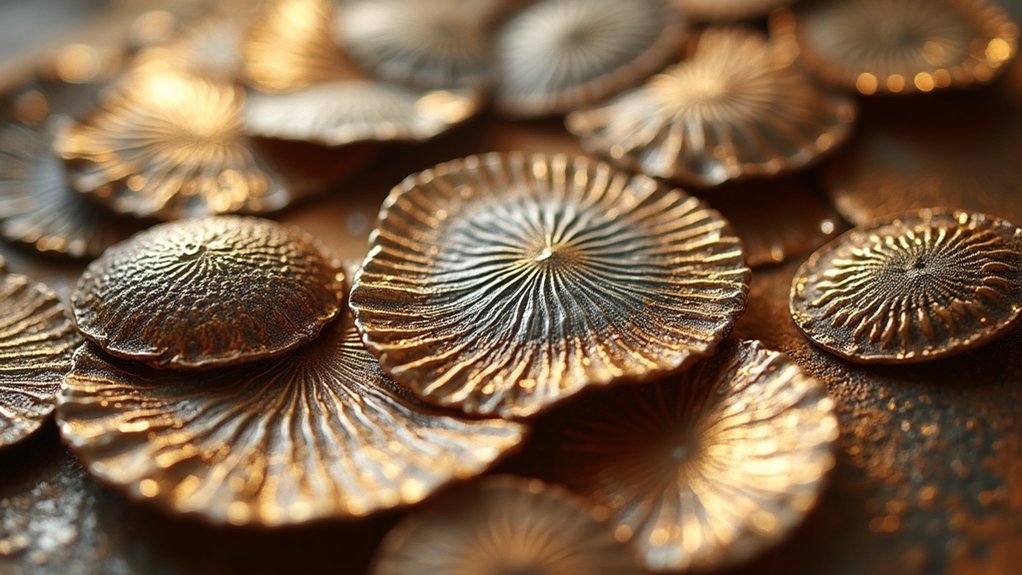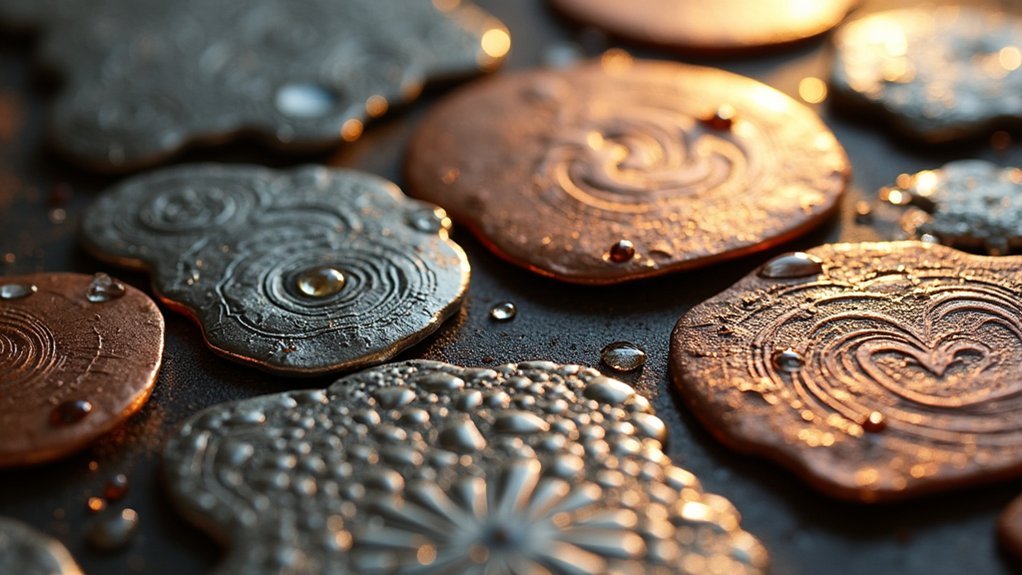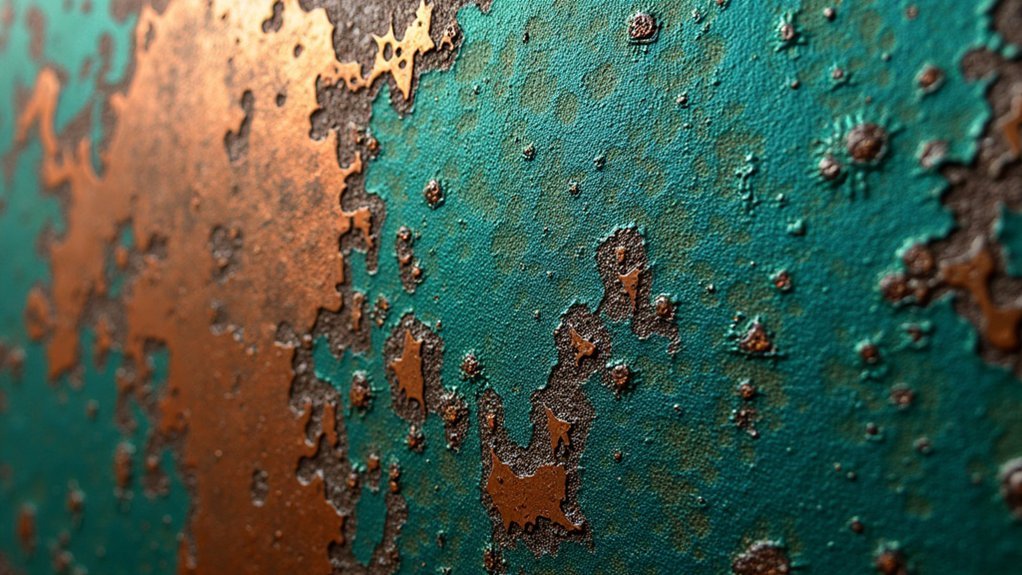Textured metals transform ordinary jewelry into enchanting art pieces that engage both sight and touch. When you add textures to metal, you create dynamic light play, visual depth, and tactile interest that flat surfaces simply can’t achieve. Your pieces will stand out in a crowded market while reflecting individual style and personality. Texturing techniques—from hammering to etching—each tell unique stories and evoke specific emotions, making your jewelry not just seen, but truly experienced.
Unleashing Visual Depth Through Textured Metals

Why settle for flat, one-dimensional metal surfaces when texture can transform your jewelry into enchanting works of art? Textured metals create a dynamic interplay of light and shadow that instantly draws the eye and elevates your pieces beyond the ordinary.
When you incorporate hammering, etching, or reticulation techniques, you’re not just altering a surface—you’re crafting a visual narrative that evokes emotion and captures attention. Each indent, line, and pattern catches light differently, creating depth that flat surfaces simply can’t achieve.
You’ll notice how thoughtfully textured metals distinguish your jewelry in a saturated market. The visual complexity doesn’t just make your pieces more interesting—it creates memorable impressions that resonate with viewers and reflects the wearer’s unique personality and style preferences.
Essential Tools and Techniques for Metal Texturing
When you’re starting to add texture to metal jewelry, you’ll need just a few essential tools—hammers, punches, and a sturdy bench block.
Hammering techniques not only create eye-catching patterns but also add dimensional qualities that transform flat metal into dynamic surfaces with light-catching properties.
Once you’ve established your textures, applying patina will dramatically enhance the depth by darkening recessed areas while highlighting raised portions, creating striking visual contrast in your finished pieces.
Essential Tools for Beginners
A well-equipped workspace forms the foundation of successful metal texturing. As you begin your journey into transforming flat metal surfaces into dimensional art, start with these fundamental tools that won’t overwhelm your budget or learning curve.
- Metal sheet and wire cutters for materials up to 0.6mm thick, providing clean edges for your base pieces.
- Ball pein hammer for creating traditional hammered finishes that catch light beautifully.
- Doming block and punches for forming gentle curves and dimensional elements.
- Dremel Multi Tool for precision cutting and shaping, making intricate designs achievable even for beginners.
Remember to learn the annealing process early—heating metal until red-hot, then quenching it—to keep your materials workable as you experiment with textures.
Expand your toolkit gradually as your skills develop.
Hammering Creates Dimension
Transform ordinary metal sheets into enchanting jewelry pieces through the ancient art of hammering. With each strike, your hammer creates unique indentations that add depth and character to the metal surface, elevating simple designs into tactile works of art.
Different hammers yield distinctive results—a ball pein creates gentle dimples while a repousse hammer produces bolder patterns. As you work the hammered metal, you’re not just changing its appearance but enhancing the wearer’s sensory experience.
You’ll discover that hammering techniques complement other texturing methods beautifully. Try combining hammered sections with etched or reticulated areas to create complex, layered textures that tell a visual story.
Mastering this fundamental technique gives your jewelry an unmistakable individuality that mass-produced pieces simply can’t match.
Patina Enhances Textures
Patinas bring hammered and textured metal surfaces to life, adding depth and drama that elevate your jewelry designs to museum-worthy status.
Liver of Sulphur (LOS) offers versatile options for creating these rich surface treatments, transforming your textured pieces with subtle or striking color variations.
- Apply a strong LOS solution to achieve deep black patinas that accentuate engraved patterns, then polish high points to create dramatic contrast between recesses and raised areas.
- Experiment with different dilutions to produce varied color effects that complement your textured metal’s unique characteristics.
- Introduce heat from a jeweller’s torch after patina application to develop vibrant, unexpected color variations across the textured surface.
- Combine patina techniques with pre-textured metals like mokume gane or crinkle sheets for complex, multi-dimensional results that capture light in fascinating ways.
The Psychology of Texture in Jewelry Design
When you run your fingers across a piece of textured metal jewelry, you’re engaging in an experience that transcends mere visual appreciation.
These textured surfaces create a tactile dialogue between you and the piece, forming an emotional connection that smooth metals simply can’t replicate.
You’ll notice how textures evoke specific feelings—hammered surfaces might suggest strength and resilience, while delicate patterns may convey elegance or whimsy.
This psychological response isn’t accidental. Designers deliberately use texture to tell stories and express artistic vision.
The interplay of light and shadow on textured metals captivates your attention, while the contrast between smooth and textured elements makes pieces more memorable.
It’s this multisensory engagement that transforms jewelry from mere adornment into objects of personal significance.
From Hammering to Etching: Mastering Different Texturing Methods

Master jewelers employ a diverse array of techniques to transform plain metal surfaces into enchanting textural landscapes.
When you’re ready to elevate your jewelry designs, these texturing methods will add depth and personality to your creations.
- Hammering with ball pein or cross pein hammers creates distinctive indentations that catch light in surprising ways.
- Etching with chemical solutions delivers precise, intricate patterns impossible to achieve by hand alone.
- Reticulation involves controlled heating and cooling to produce organic, rippled surfaces unique to each piece.
- Granulation fuses tiny metal beads to surfaces, creating dotted textures with dimensional appeal.
Combining Textures for Distinctive Jewelry Pieces
When you’re creating jewelry with multiple textures, start by pairing contrasting surfaces like matte finishes against high polish for immediate visual impact.
You’ll find that layering different textural elements—perhaps combining subtle rolling mill impressions with bold hammer marks—creates depth that draws viewers in to examine your work more closely.
Consider how each texture relates to the others in your piece, ensuring they complement rather than compete, which will elevate your design from merely interesting to truly distinctive.
Texture Layering Principles
The strategic combination of multiple textures transforms ordinary metal jewelry into enthralling wearable art that demands attention.
When you layer at least three distinct textures, you create visual depth that draws the eye across your entire piece, telling a tactile story through your metalwork.
- Contrast light brass finishes against heavy hammer marks to create dramatic visual tension.
- Position textures strategically to guide the viewer’s eye through your metal composition.
- Use rolling mills to create consistent background textures before adding focal elements.
- Overlap different patterns sparingly to maintain harmony in your design.
As you experiment with these layering techniques, you’ll develop your unique artistic voice.
Remember to balance complexity with coherence—each texture should contribute to the piece’s overall aesthetic without creating visual chaos.
Contrasting Surface Treatments
Striking visual tension emerges when you deliberately juxtapose opposing surface treatments on metal jewelry. By combining hammered and polished finishes, you’ll create eye-catching pieces that draw attention to your craftsmanship.
These contrasting surface treatments don’t just look beautiful—they tell stories.
You’ll find that pairing smooth areas with rough textures naturally guides the viewer’s eye to focal points in your design. Try layering light brass with heavy hammer patterns to add depth that transforms flat metal into dynamic art.
The tactile experience becomes as important as the visual appeal.
When you incorporate techniques like etching alongside granulation, you’re creating jewelry that engages multiple senses. Your clients will connect personally with these pieces, appreciating how the interplay of textures makes each creation truly unique.
Enhancing Metal Patina on Textured Surfaces

Masterfully created textures on metal jewelry serve as perfect canvases for dramatic patina effects, where each ridge, valley, and impression becomes an opportunity for chemical transformation.
When you apply Liver of Sulphur to textured surfaces, you’ll immediately notice how it settles differently across varying depths, enhancing the visual complexity of your piece.
- Polish the high points after patination to reveal the underlying metal, creating striking contrast between darkened recesses and gleaming peaks.
- Apply heat treatment after LOS to introduce vibrant blues, purples, and golds that dance across your textured surface.
- Experiment with different metal types to discover unique patina reactions specific to each material.
- Use deep engravings or pronounced textures to create dramatic shadow effects as patina settles into recesses.
Frequently Asked Questions
What Is Texturing in Jewellery?
Texturing in jewelry is when you alter metal surfaces to create visual interest and tactile appeal. You’ll find techniques like hammering, etching and reticulation that add depth through light and shadow interactions on your pieces.
What Is Textured Metal Called?
Textured metal is commonly called “textured metal sheet” or simply “textured metal” in jewelry making. You’ll also hear specific terms like hammered, etched, or reticulated metal depending on the technique that’s been applied.
Why Would Transition Metals Be Good for Jewelry?
Transformation metals are perfect for your jewelry because they’re malleable, allowing intricate designs. You’ll appreciate their durability, corrosion resistance, and ability to develop unique patinas that make each piece distinctively yours.
How Do You Add Texture to Metal Jewelry?
You can add texture to metal jewelry by hammering to create indentations, using a rolling mill for pattern transfers, pressing fabrics into metal, layering different textures, or experimenting with stamping and etching techniques.
In Summary
You’ve seen how textured metals transform ordinary jewelry into stunning art. By exploring hammering, etching, and combining techniques, you’re now equipped to create pieces with visual depth and personality. Remember, texture isn’t just about aesthetics—it connects emotionally with wearers. Continue experimenting with different tools and patinas to develop your unique style and make jewelry that truly stands out in today’s market.





Leave a Reply